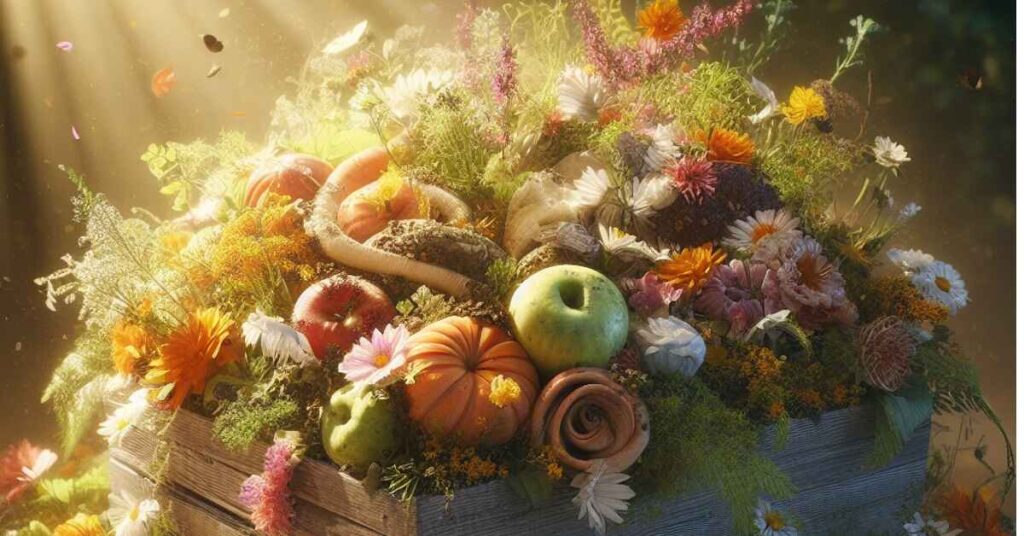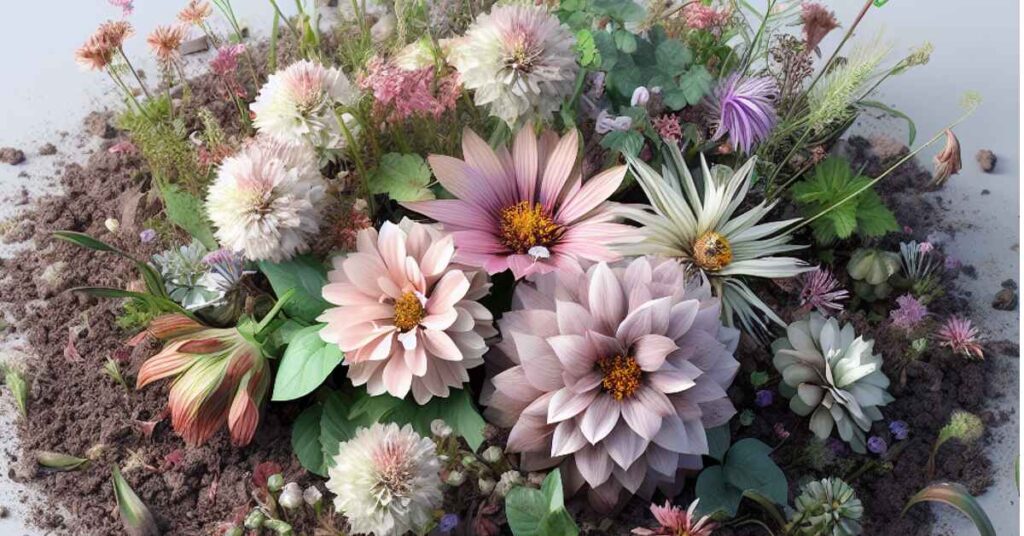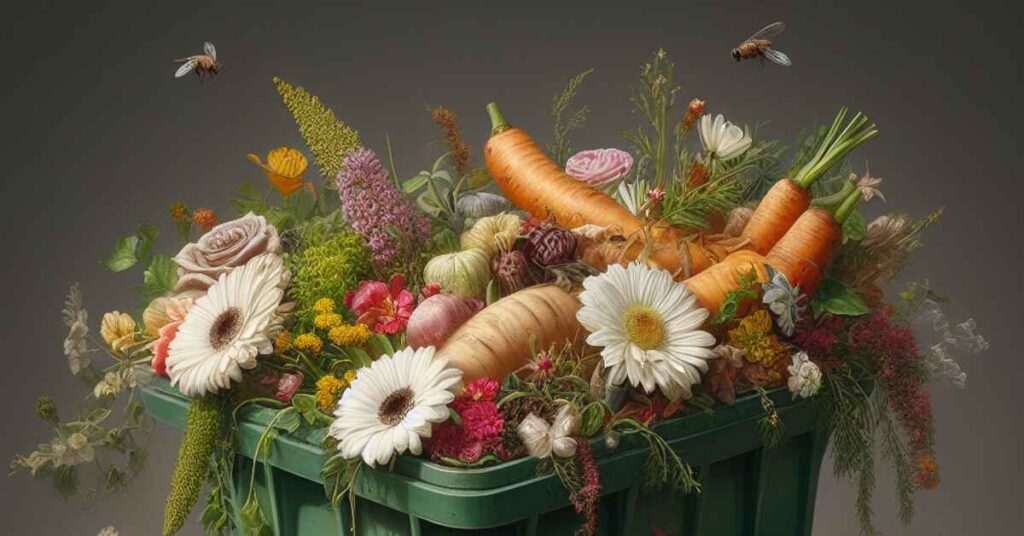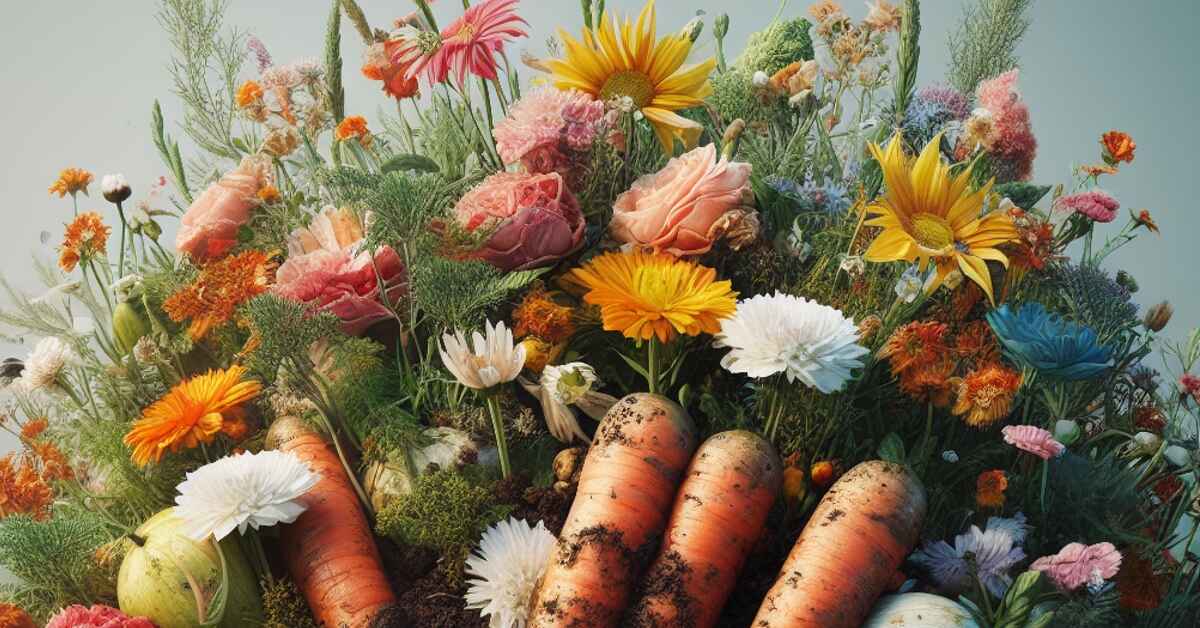In the quest for sustainable gardening practices, composting emerges as a key player, and when it comes to compostable materials, flowers often come into question. Can you compost flowers? The answer is a resounding yes.
Composting flowers not only diverts waste from landfills but also transforms it into a valuable resource for gardeners. This article delves into the world of composting flowers, unraveling its myriad benefits and guiding you through the process of turning floral waste into garden gold.

Can You Compost Flowers?
Yes, you can compost flowers, and they can be a valuable addition to a compost pile. Composting flowers is a great way to recycle plant material back into the soil, contributing to a sustainable garden ecosystem. When flowers are added to compost, they decompose along with other organic matter, eventually turning into humus, a nutrient-rich material that greatly benefits soil health and plant growth. If you happen to leave some flowers in your car, and they go bad overnight, composting them is always a good idea!
How to Compost Flowers – A Complete Guide
When composting flowers, there are several important considerations to ensure effective decomposition and maintain a healthy compost balance.
Remove Diseased or Pest-Infested Flowers
It’s crucial to avoid adding flowers that show signs of disease or pest infestations to your compost. These issues can persist in the compost and later affect other plants where the compost is used. Diseases and pests can survive the composting process, especially if the pile does not reach sufficiently high temperatures to kill pathogens. Dead sunflower heads are fine, but only if they aren’t diseased!
Adding diseased plant material can inadvertently spread fungi, viruses, bacteria, or pests to your garden. Inspect flowers carefully for any signs of disease or infestation, such as unusual spots, rot, mildew, or visible insects, and discard these in the trash or burn them, if permissible.
Remove Inorganic Materials
Before composting flowers, especially those from bouquets, it’s essential to remove all inorganic materials. Plastic wraps, ribbons, wires, and synthetic decorations do not decompose and can introduce contaminants into your compost. These materials can also hinder the composting process by reducing aeration and creating physical barriers. ‘
Furthermore, the presence of inorganic materials in compost can be problematic when the finished compost is used, leading to pollution and harming the natural environment. Always ensure that only biodegradable, organic materials are added to maintain the purity and quality of your compost.
Chop or Break Up Large Blooms
Composting larger flowers more effectively involves chopping or breaking them into smaller pieces. This process speeds up decomposition by increasing the surface area available for microorganisms to work on.
Large blooms, if left whole, can create dense clumps in the compost pile, which might slow down the composting process due to inadequate aeration and uneven moisture distribution. Smaller pieces decompose more uniformly and mix better with other compost materials, ensuring a more efficient and faster composting process. This step is especially important for thick-stemmed or bulky flowers.
Balance with Other Compost Materials
Flowers, being rich in nitrogen, are an excellent addition to the compost pile. However, for effective composting, it’s important to balance nitrogen-rich materials (greens) like flowers with carbon-rich materials (browns), such as dry leaves, straw, or shredded paper.
This balance is critical to maintain the compost’s carbon-to-nitrogen ratio, which should ideally be around 30:1. Too much nitrogen can lead to a smelly, overly moist pile, while too much carbon can slow down the composting process. A well-balanced compost pile decomposes efficiently and produces high-quality compost.
Consider Compost Composition
When adding a significant amount of flowers to your compost, especially those treated with chemicals or pesticides, be cautious. These substances can remain in the compost and potentially transfer to plants where the compost is applied.
This is particularly concerning for edible plants, as it might affect food safety. Therefore, it’s advisable to compost organically grown flowers, or at least be aware of what chemicals have been used on the flowers being composted. Understanding the origin and treatment of the flowers can help you make informed decisions about where to use the finished compost.
Avoid Weeds
Exercise caution when adding flowers that have gone to seed or including weeds in the compost pile. Many seeds can survive the temperatures in a compost pile and may germinate when the compost is spread in the garden.
This can lead to unwanted weed growth and additional gardening work. To prevent this, avoid composting flowers and plants that are seeding or are known to be invasive. If you do add them, ensure your compost pile reaches high enough temperatures to kill the seeds, which often requires careful management and turning.
Turn the Compost Regularly
Regular turning is an essential step in managing a compost pile. Turning the compost aerates the pile, providing oxygen necessary for the microorganisms that break down the organic matter.
Oxygen helps maintain aerobic conditions, which speeds up the composting process and prevents foul odors caused by anaerobic decomposition. Regular turning also helps distribute moisture and heat evenly throughout the pile, further facilitating efficient decomposition. A well-aerated compost pile not only decomposes faster but also produces higher quality compost, rich in nutrients and beneficial for garden soil.
The Benefits of Composting Flowers
Composting flowers offers a range of benefits, both environmentally and for gardening purposes.

Waste Reduction
Composting flowers is an excellent way to reduce garden waste. Instead of discarding floral waste in the trash, composting turns it into something useful, thereby reducing the amount of waste sent to landfills.
Soil Improvement
Compost made from flowers enriches the soil. As the flowers decompose, they turn into humus, a nutrient-rich material that improves soil structure, fertility, and health. This enhanced soil is better at retaining moisture and nutrients, leading to healthier plant growth.
Nutrient Recycling
Flowers in compost break down and release nutrients back into the soil. This process recycles nutrients that would otherwise be lost, providing a natural, slow-release fertilizer for plants.
Eco-Friendly
Composting is an environmentally friendly practice. By composting flowers, you are utilizing a natural process to recycle organic material, thereby reducing your carbon footprint and promoting sustainability. It’s a great way to fuel that bee-friendly garden!
Pest and Disease Control
Properly composted material can help suppress certain soil-borne diseases and pests. The process of composting generates heat, which can kill off some pathogens and weed seeds.
Water Conservation
Compost improves soil structure, enhancing its ability to hold water. This reduces the need for frequent watering and makes your garden more drought-resistant.
Encourages Beneficial Organisms
Adding compost to your garden supports a diverse range of beneficial organisms, such as earthworms and beneficial microbes. These organisms play a crucial role in soil health and nutrient cycling.
Reduces the Need for Chemical Fertilizers
Compost provides a natural alternative to chemical fertilizers. It releases nutrients slowly, which is healthier for plants and the environment.
Balances Soil pH
Over time, composting can help balance the pH levels of your soil, making it suitable for a variety of plants.
Aesthetic Benefits for Gardens
Using compost can improve the overall appearance of your garden. Healthy plants and improved soil lead to a more vibrant and flourishing garden.
Educational Value
Composting provides an educational experience about the cycle of nature and the importance of sustainability. It’s a hands-on way to learn about waste reduction and ecological responsibility.
Cost-Effective
Composting is a cost-effective way to produce rich garden amendments. Instead of purchasing compost or fertilizers, you can create your own from waste materials, including flowers.
Reduces Greenhouse Gas Emissions
Composting organic material, like flowers, reduces the emission of greenhouse gases, particularly methane, which is produced when organic matter decomposes anaerobically in landfills.
What To Do With Composted Flowers?
Once you have composted flowers and the compost is fully processed, there are numerous ways to use this nutrient-rich material in your garden and for various planting needs. Here’s a list of what you can do with composted flowers.

Soil Amendment
Mix the compost into your garden soil. This improves soil structure, increases nutrient content, and enhances soil fertility, making it more conducive for plant growth.
Potting Mix
Use the compost in making potting mix for potted plants or container gardens. It can be mixed with other potting materials to provide a rich, nutrient-dense medium for growing plants.
Top Dressing for Plants
Spread a thin layer of compost around the base of plants as a top dressing. This helps in slowly releasing nutrients to the plants and retains soil moisture.
Lawn Care
Compost can be used as a lawn conditioner. Spread it thinly over your lawn to improve grass health and soil quality.
Vegetable and Flower Gardens
Incorporate the compost into vegetable beds or flower gardens. It provides essential nutrients and improves soil structure, which is beneficial for both edible and ornamental plants.
Mulching
Compost can be used as mulch around trees, shrubs, and garden beds. It helps in suppressing weeds, retaining moisture, and slowly releases nutrients into the soil.
Tree and Shrub Planting
When planting or transplanting trees and shrubs, mix compost into the backfill soil. This will give the plants a nutrient boost and improve root growth.
Erosion Control
Compost can help in controlling erosion in susceptible areas by improving soil structure and encouraging the growth of vegetation.
Rejuvenating Old Soil
Mix compost with old, tired soil to rejuvenate it. This is particularly useful for revitalizing soil in raised beds or perennial gardens.
Seed Starting
You can use a fine-textured, sifted compost to help start seeds. Its nutrient-rich nature provides a great start for seedlings.
Healing Damaged Spots
Use compost to repair or fill in bare or damaged spots in your lawn or garden beds.
Compost Tea
Brew compost tea from your composted flowers and use it as a liquid fertilizer or foliar spray. This tea provides a quick, nutrient-rich supplement for plants.
Remember, the key to successful use of compost is ensuring it’s fully decomposed and matured. Fresh or partially decomposed compost can harm plants due to its high organic acid content and potential heat generation. Mature compost should be dark, crumbly, and have an earthy smell.
Conclusion
Composting flowers is more than just a method of waste disposal; it’s a step towards an eco-friendly gardening practice. By transforming spent blooms into nutrient-rich compost, gardeners can enrich their soil, foster plant growth, and contribute to a healthier ecosystem. The benefits of composting flowers extend beyond nourishing the garden – it’s a testament to the cycle of nature and sustainability. Embracing this practice allows us to give back to the earth, creating a harmonious balance in our gardens and environment.
